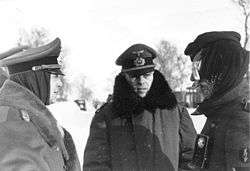Richard Ruoff
Richard Ruoff (18 August 1883 – 30 March 1967) was a general in the Wehrmacht of Nazi Germany during World War II. He commanded the 4th Panzer Army and the 17th Army on the Eastern Front.
Richard Ruoff | |
|---|---|
 Richard Ruoff (left) in the Soviet Union. | |
| Born | 18 August 1883 Meßbach, German Empire |
| Died | 30 March 1967 (aged 83) Tübingen, West Germany |
| Allegiance | |
| Service/ | Army |
| Rank | |
| Commands held | 4th Panzer Army 17th Army |
| Battles/wars | World War II |
| Awards | Knight's Cross of the Iron Cross |
World War II
Ruoff took command of V Army Corps on 1 May 1939, and led this unit into World War II. He also concurrently commanded V Wehrkreis in Stuttgart.[1] Ruoff then was given command of the 4th Panzer Army from 8 January 1942 to 31 May 1942. The 4th Panzer Army was part of Army Group A which was formed when Army Group South was split into two formations for the summer offensive of 1942.
Ruoff commanded the 17th Army from 1 June 1942 to 24 June 1943. The 17th Army was also part of Army Group A. Ruoff was the commander of the 17th Army when, on 3 June 1942, the Italian Expeditionary Corps in Russia was briefly subordinated to it. From June to July, the German 17th Army, the CSIR, and the Romanian 3rd Army were organized as "Army Group Ruoff". By July 1942, Ruoff lost the Italian unit. The CSIR was subsumed by the larger Italian Army in Russia (Armata Italiana in Russia, or ARMIR) and transferred to Army Group B (Heeresgruppe B).
During the late summer, as part of Army Group A, Ruoff and the 17th Army attacked towards the Caucasus oilfields. By December, Soviet forces had destroyed the armies defending its flanks (including the ARMIR) and had en-circled the German 6th Army at Stalingrad. Army Group B was withdrawn from southern Russia but Ruoff and the 17th Army were ordered to hold the "Kuban bridgehead." In June 1943, he was moved to the command reserve, and saw no further action during the war.
Serious allegations of war crimes were levied against the 17th Army under Ruoff's command in the 1943 Krasnodar Trial conducted by the military tribunal of the Soviet North Caucasian Front.[2] However, post-war, the Soviet Union did not seek Ruoff's extradition.[3]
Command History
- General Officer Commanding, 4th Panzer Army, Eastern Front - 1942
- General Officer Commanding, 17th Army, Eastern Front - 1942 to 1943
Awards and decorations
- Iron Cross(1914)[4]
- Knight's Cross of the Military Merit Order (Württemberg)[4]
- Knight's Cross, First Class of the Friedrich Order (Württemberg)[4]
- Knight's Cross of the Iron Cross on 30 June 1941 as General der Infanterie and commander of V. Armeekorps[5]
References
Citations
- , Glantz & House 2009, p. 23.
- Smelser & Davies 2008, p. 39.
- Parrish 1996, p. 128.
- Rangliste des Deutschen Reichsheeres, p. 120.
- Scherzer 2007, p. 646.
Bibliography
- Glantz, David M.; House, Jonathan (2009). To the Gates of Stalingrad: Soviet-German Combat Operations, April-August 1942. Lawrence, Kansas: University Press of Kansas. ISBN 978-0-7006-1630-5.CS1 maint: ref=harv (link)
- Parrish, Michael (1996). The Lesser Terror: Soviet State Security, 1939–1953. Praeger Press. ISBN 978-0-275-95113-9.CS1 maint: ref=harv (link)
- Reichswehrministerium, ed. (1930). Rangliste des Deutschen Reichsheeres (in German). Berlin, Germany: Mittler & Sohn Verlag. OCLC 10573418.
- Scherzer, Veit (2007). Die Ritterkreuzträger 1939–1945 Die Inhaber des Ritterkreuzes des Eisernen Kreuzes 1939 von Heer, Luftwaffe, Kriegsmarine, Waffen-SS, Volkssturm sowie mit Deutschland verbündeter Streitkräfte nach den Unterlagen des Bundesarchives [The Knight's Cross Bearers 1939–1945 The Holders of the Knight's Cross of the Iron Cross 1939 by Army, Air Force, Navy, Waffen-SS, Volkssturm and Allied Forces with Germany According to the Documents of the Federal Archives] (in German). Jena, Germany: Scherzers Militaer-Verlag. ISBN 978-3-938845-17-2.CS1 maint: ref=harv (link)
- Smelser, Ronald; Davies, Edward J. (2008). The Myth of the Eastern Front: the Nazi-Soviet war in American popular culture. New York: Cambridge University Press. ISBN 9780521833653.CS1 maint: ref=harv (link)
| Military offices | ||
|---|---|---|
| Preceded by General der Infanterie Hermann Geyer |
Commander of V. Armeekorps 1 May 1939 – 12 January 1942 |
Succeeded by General der Infanterie Wilhelm Wetzel |
| Preceded by Generaloberst Erich Höpner |
Commander of 4. Panzer-Armee 8 January 1942 – 31 May 1942 |
Succeeded by Generaloberst Hermann Hoth |
| Preceded by Generaloberst Hans von Salmuth |
Commander of 17. Armee 1 June 1942 – 24 June 1943 |
Succeeded by Generaloberst Erwin Jaenecke |